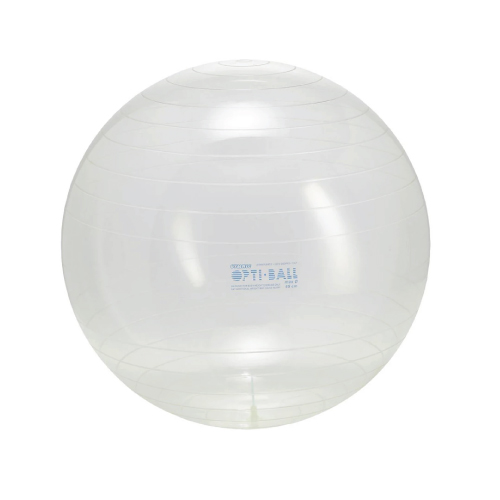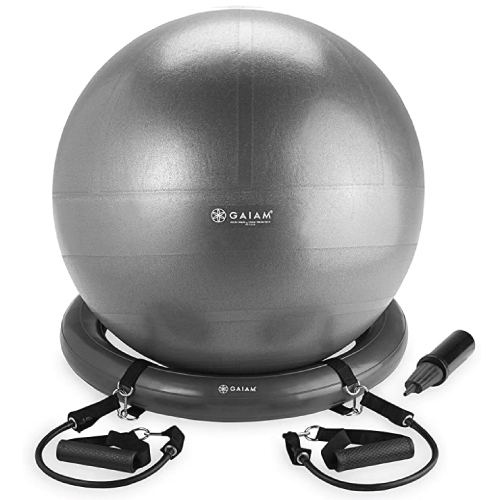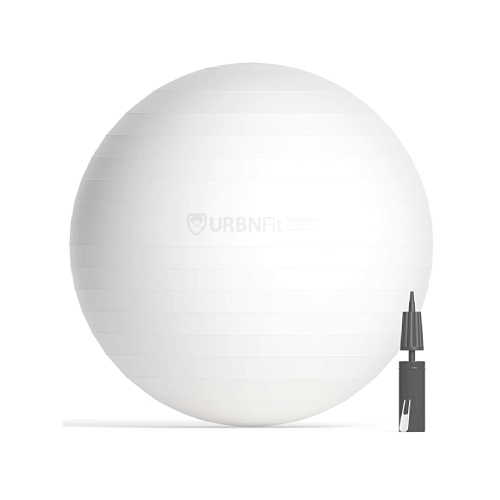What’s perfectly symmetrical, supportive, challenging, talk back without saying a word, and is a little bit of a softie? Here’s a hint… I’m not talking about a person. 😀
I’m talking about an exercise ball. The exercise ball (aka yoga ball, Pilates ball, stability ball, or physioball) can be everything you need in your life. Make the exercise ball your newest chair, enhance stretches, be challenged down to your deepest core, and feel the support. Without saying a word, other than the occasional awkward squishing sound, the unstable rolling and squishiness of the exercise ball reinforces the need for deep core muscle firing while giving support to your spine, hips, shoulders, neck, or whatever it comes in contact with. It can be the coach that pushes you or your best friend that carries you along the way.
Does it sound like I spend a little too much time with my exercise ball? When teaching my students virtually, an exercise ball is in the top 3 pieces of equipment I recommend they, and everyone, have at home. I am amazed at how many different exercise objectives we can address for all levels using one simple prop.
Personally, I love the supported back extension, and side-lying work. It helps me to cancel out the unwanted lower back extension during thoracic and hip extension focussed exercises.
Why should you own an exercise ball?
- It can alternate or replace your desk chair. Sometimes we get stuck in one position or poor ergonomics, so switching things up is always a good idea.
- It can support your lower back when doing “ab” work. It gives you feedback and helps your body to understand how to connect to the deeper muscles that are more supportive of your spine
- It wakes up your deepest abdominals. Simply sitting on the physioball will ignite your transverse abdominals, or you will wobble/ fall off. This auto fire of the deepest layer of abdominals is sometimes hard for us to fire when we don’t really “have to.” Basically, the ball keeps us honest.
- It can help the feeling of “gripping” hip flexors. Besides some great stretches, the physioball can support your legs in a table-top position, where we can experiment with hip disassociation, and feel healthy hip flexion. This posture is often avoided by people with compromised spines or those with hip injuries. Simply resting the legs on the ball when lying on the floor will help your body understand that it can work the hips flexors in a healthy way. As always consult with your doctor before trying!
- You can feel like a gymnast. Backbends up the ball, standing pikes. All so fun.
- You can learn to shake those hips. Sitting on the physioball and isolating the motions of the pelvis and the torso is one of the best ways to unlock freedom in the hips and the ribs.
- Stabilize your trunk while you access muscles in the extremities (arms and legs) that you might not feel as much without the ball.
- It doesn’t take up too much space.
- Your dog might love to play soccer with it. My little pup goes nuts for it. Just watch out not to let them knock over someone or something.
Where to Purchase an Exercise Ball
I love this clear one.



Tips to Keep in Mind
- Get the right size and the right amount of firmness. 65cm is a good standard size for most people 5’3”-6’ tall. Otherwise, try the 55cm or 75cm. Blow it up so that you can sit comfortably without deflating it more than 3-4 inches. Don’t blow it up until it feels like it is so firm that it has no give.
- Start by getting comfortable sitting on it. They sell ball chairs with a base (usually 55cm and then the base makes it more like 65cm so that it ergonomically works with a standard desk.
- This is good and will fire your natural balance muscles also, but not as much as without a base.
- Barefoot or a sticky surface is best under your feet.
- Start with a few exercises that you enjoy and get you feeling secure moving around on the ball before more challenging balancing exercises.
- Remember that the ball will make you feel a little wobbly. This is good. It is your body responding to the instability. That is how you get stronger!
- Be careful, try a lesson with a trainer or Pilates instructor, and have fun!
Exercise Ball Workout
Here are some of our favorite at-home exercises that can be a technical workout, warm-up, cool down, or break from work.
***
Back Extension
Set Up- Prone on the ball, toes curled under, knees bent and hovering off the floor, elbows bent to sides, fingers facing each other
Move-
Inhale: Articulate the spine up beginning with the head, Straighten the legs, arms straighten, hands press into the ball, fingers reach toward the floor.
Exhale: Lower back to starting position
Tips:
* Keep abdominals supporting the spine.
*Use the hip and upper back extensors
*Use the pressing of the hands and feet into the floor and ball for support and strength
***
Flying
Setup- Prone with ribs at the apex of the ball, legs straight, toes anchored, spine in a lifted position
Move:
Inhale: Lift arms to sides, palms face the mat
Exhale: Stay
Inhale: Reach arms overhead
Exhale: Reach arms into sides
Tips:
*Keep palms facing the floor
*try with bent knees hovering or on the mat to make it less challenging
*Try to keep the arms at the same level
***
Pelvic Curl
Set Up- Lay supine, legs long and sit bone width, feet on the ball with the knees slightly bent
Move-
Exhale: Articulate the spine off the mat beginning with the sacrum allowing the legs to straighten
Inhale: Hold, feeling the muscles in the back of the legs and glutes
Exhale: Roll down
Tips:
*Press into the hands and back of arms to avoid resting on the neck.
* lift from the muscles in the back of the legs and right around the sits bones rather than the lower back.
***
Roll Up W/ Extension
Set up- sit slightly forward of the center of the ball with the legs straight. Round over into C curve, shoulders over hips.
Move- Exhale: Roll back using the abdominals, allowing the knees to bend. Ground your feet into the floor Inhale & Exhale: stretch as far back over the ball as possible, allowing the neck to lay on the ball.
Inhale: arms reach inline with shoulders, articulate cervical spine off the ball.
Exhale: Continue rolling all the way over into your starting position, maintaining elongated flexion throughout.
Tips:
*ground your feet, or place them against a wall.
*Make this only as big as you feel pain-free. A smaller version is also demonstrated in the video clip.
***
Pelvic Tilts + Side Bend
Set Up- Sit upright on the ball, grounded feet
Move- Rock hips Right and Left to mobilize
Inhale: Move hips to the right and side bend to the left
Exhale: lifting up through the top arm and obliques to return to a seated position
Repeat each side 5-8 times
Tips:
* keep spine neutral & abdominals strong
* side bend over as far over as the pelvis can go in the opposite direction.
*Think strong first before range-of-motion
***
Side Leg Lifts
Setup- kneeling, lean your waist and torso against the ball, inside knee angled slights away from the ball for balance. Extend the top leg long to your side with the body in one long line. Hands behind the head or with one hand on the ball for balance.
Move-
Exhale: lift the leg up in parallel to hip height or however high you can maintain your posture
Inhale: lower the leg
Tips:
*Imagine being between 2 panes of glass. Maintaining a neutral pelvis.
*Ground down into your bottom leg
*Keep the top leg straight.
***
Standing Cat Stretch
Setup- Standing tall with the ball against your legs.
Exhale: Roll down leading with the head & lengthen out to a flat back
Inhale: Press down into the ball, extend the spine leading with the head
Exhale: Reach back to a flat back
Inhale: Stay
Exhale: Roll up to standing leading with the tailbone.
Tips:
* Feel your hand pressing down into the ball to help access the upper back extensors.
* Feel the sits bones reaching up to the ceiling when in the flat back position for an increased hamstring stretch
* try with bent knees or kneeling